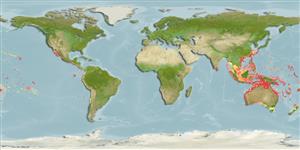>
Mulliformes (Goatfishes) >
Mullidae (Goatfishes)
Etymology: Parupeneus: Latin, parum, parvum = small + Peneus, the name of a river.
More on author: Bleeker.
Environment: milieu / climate zone / depth range / distribution range
Ecología
marino; salobre asociado a arrecife; rango de profundidad 10 - 80 m (Ref. 90102). Tropical; 30°N - 50°S
Western Pacific: Japan to Western Australia, New Caledonia and northern New Zealand. Recently reported from Tonga (Ref. 53797).
Tamaño / Peso / Age
Maturity: Lm ? range ? - ? cm
Max length : 50.0 cm TL macho / no sexado; (Ref. 9002)
Espinas dorsales (total): 8; Radios blandos dorsales (total): 9; Espinas anales 1; Radios blandos anales: 7.
Inhabits coastal reefs and estuaries (Ref. 9002); in Indonesia mainly found on deep reefs adjacent to strong currents (Ref. 90102). Juveniles found in small schools; adults singly or in small aggregations (Ref. 9002, 48636). May also be solitary. It is rare in the East Indian region, and found only in cool areas of upwelling; but is common in subtropical latitudes (Ref. 90102).
Life cycle and mating behavior
Madurez | Reproducción | Puesta | Huevos | Fecundidad | Larva
Randall, J.E., G.R. Allen and R.C. Steene, 1990. Fishes of the Great Barrier Reef and Coral Sea. University of Hawaii Press, Honolulu, Hawaii. 506 p. (Ref. 2334)
IUCN Red List Status (Ref. 130435)
Threat to humans
Harmless
Human uses
Pesquerías: comercial
Más información
Nombres comunesSinónimosMetabolismoDespredadoresEcotoxicologíaReproducciónMadurezPuestaAgregación para la puestaFecundidadHuevosEgg development
ReferenciasAcuiculturaPerfil de acuiculturaRazasGenéticaElectrophoresesheritabilidadEnfermedadesProcesamientoNutrientsMass conversion
ColaboradoresImágenesStamps, Coins Misc.SonidosCiguateraVelocidadTipo de nataciónSuperficie branquialOtolitosCerebrosVisión
Herramientas
Special reports
Download XML
Fuentes de Internet
Estimates based on models
Preferred temperature (Ref.
123201): 18 - 28.7, mean 27.2 °C (based on 446 cells).
Phylogenetic diversity index (Ref.
82804): PD
50 = 0.5000 [Uniqueness, from 0.5 = low to 2.0 = high].
Bayesian length-weight: a=0.01259 (0.00753 - 0.02106), b=3.04 (2.90 - 3.18), in cm total length, based on LWR estimates for this species & Genus-body shape (Ref.
93245).
Nivel trófico (Ref.
69278): 3.5 ±0.2 se; based on diet studies.
Resiliencia (Ref.
120179): Medio, población duplicada en un tiempo mínimo de 1.4-4.4 años (Preliminary K or Fecundity.).
Fishing Vulnerability (Ref.
59153): Moderate vulnerability (40 of 100).
Nutrients (Ref.
124155): Calcium = 25.9 [12.6, 57.8] mg/100g; Iron = 0.268 [0.134, 0.621] mg/100g; Protein = 18.1 [14.8, 21.2] %; Omega3 = 0.13 [0.07, 0.25] g/100g; Selenium = 55.7 [26.1, 153.8] μg/100g; VitaminA = 164 [29, 748] μg/100g; Zinc = 0.573 [0.339, 1.075] mg/100g (wet weight);
